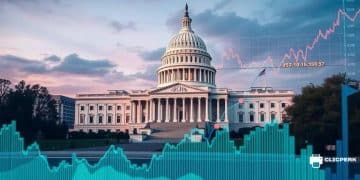Bank deregulation initiatives under Trump: What you need to know

Bank deregulation initiatives under Trump aim to increase lending and stimulate economic growth, but they raise concerns about financial stability and consumer protection due to reduced oversight.
Bank deregulation initiatives under Trump have sparked significant debate, raising questions about their impact on the financial sector and the broader economy. What changes did these initiatives bring, and how do they affect everyday Americans?
Overview of bank deregulation under Trump
The overview of bank deregulation under Trump reveals a pivot in U.S. financial policy. Following years of strict regulations, the administration aimed to ease restrictions imposed after the 2008 financial crisis. This shift was promoted as a means to foster economic growth and increase lending by the banks.
One of the pivotal changes was the rollback of specific components of the Dodd-Frank Act, which was established to guard against financial crises. This act included measures aimed at controlling risk in the banking system. With deregulation, banks gained more flexibility, which raised concerns among some economists about potential risks to financial stability.
The primary areas of deregulation
Notably, several key areas were affected. These include:
- Capital Requirements: Banks faced reduced capital requirements, which critics argue could lead to riskier lending practices.
- Volcker Rule Adjustments: This rule, designed to limit speculative investments by banks, was made less stringent.
- Stress Testing Revisions: Requirements for stress tests were scaled back, raising questions about banks’ preparedness for economic downturns.
As a result, many financial experts began to voice concerns. They feared that removing such protections could lead to a repeat of the financial crises experienced in the past. In contrast, proponents argue that deregulation encourages greater efficiency and innovation within the financial sector.
The banking landscape began to change. Without the constraints of rigorous oversight, banks started to pursue more aggressive strategies to attract borrowers. The immediate effects were seen in increased loan availability for consumers and businesses, yet the long-term implications remain debated among policymakers.
Community and small business impacts
Moreover, it was expected that bank deregulation initiatives would benefit small businesses, which often struggle to secure financing. By reducing the regulatory burden, banks could make more loans available. This aspect was particularly crucial for fostering entrepreneurship in a recovering economy.
However, the efficacy of these initiatives continues to draw scrutiny. While some small businesses reported increased access to loans, others expressed concerns about rising interest rates and fees. Striking a balance between deregulation and protection is an ongoing challenge as the financial landscape evolves.
The rollback of Dodd-Frank regulations
The rollback of Dodd-Frank regulations was a key element of the Trump administration’s approach to banking. These regulations were originally put in place after the 2008 financial crisis to prevent similar events in the future. By removing certain provisions, the government aimed to stimulate economic growth.
One major change involved the easing of stress testing requirements for banks. Originally, these tests ensured that banks had enough capital to survive economic downturns. By rolling back these requirements, critics argued that banks could engage in riskier practices without sufficient scrutiny.
Key aspects of the rollback
Several important points emerged from the rollback:
- Smaller banks benefited: Many smaller banks were exempted from some of the stringent regulations, allowing them to lend more freely.
- Increased lending activity: With fewer restrictions, banks became more aggressive in their lending activities, which many viewed as a positive for consumers.
- Concerns over risk: As regulations lessened, fears arose that banks might take on excessive risk, potentially destabilizing the financial system.
This shift prompted debate among economists and policymakers. Supporters believed it would enhance economic activity, while opponents warned of the dangers associated with less oversight. The discussions surrounding the rollback highlight the delicate balance between promoting growth and ensuring stability.
Furthermore, the rollback of the Dodd-Frank regulations had wider implications for financial transparency. Investors and consumers alike started to express concerns over whether they could trust the banking system without strong safeguards in place. As this dialogue progressed, it became clear that many Americans were worried about the potential consequences of these policy changes.
Impact on consumers and small businesses

The impact on consumers and small businesses stemming from the bank deregulation initiatives under Trump has been significant. With reduced regulations, some argue that consumers could gain access to more financial products, while others fear potential pitfalls.
For many small businesses, the atmosphere of deregulation brought hope. Lenders could operate with fewer restrictions, which meant that securing loans became somewhat easier. Entrepreneurs often found themselves better positioned to access the capital needed to start or grow their businesses.
Advantages for consumers and small businesses
Here are some positive effects seen by consumers and small business owners:
- Increased access to credit: Many small businesses reported a higher approval rate for loans, enabling them to invest in growth.
- Competitive interest rates: With more lenders in the market, competition helped to drive interest rates down.
- Innovative financial products: Banks were able to offer new and diversified products aimed at meeting the unique needs of consumers and businesses.
However, these benefits have come with concerns. Without the safeguards provided by stricter regulations, many consumers worry about their financial security. Issues such as hidden fees and predatory lending practices have resurfaced, putting some borrowers at risk.
Moreover, while deregulation opened doors for lending, it also raised questions about accountability. Small businesses and consumers alike may find themselves facing challenges when financial institutions operate with less oversight. As competition increases, the risk of encountering unscrupulous lending practices also looms larger.
Understanding the full scope of the impact on consumers is essential. While access to capital has improved for many, the underlying risks associated with less regulation cannot be ignored. Striking a balance between ensuring that lending remains accessible while protecting consumers from potential harm is a critical discussion.
Reactions from financial institutions and experts
The reactions from financial institutions and experts to the bank deregulation initiatives under Trump have been varied and often polarized. Many financial institutions welcomed the changes, seeing them as opportunities to enhance profitability and foster innovation.
On one hand, larger banks expressed support for the deregulation efforts. They believed that removing certain restrictions would allow them to operate more freely and effectively meet the needs of their clients. This sentiment was particularly strong among executives who felt the prior regulations stifled growth and competitiveness.
Support from financial institutions
Several key points emerged from the banking sector:
- Increased lending opportunities: Banks anticipated they could extend more loans to consumers and businesses without the burden of excessive regulations.
- Cost reduction: Many institutions expected to save on compliance costs, allowing them to invest in other areas of growth.
- Market competitiveness: The ability to take on more risks was viewed as a way to increase their market shares.
Conversely, financial experts and economists expressed caution. Many raised red flags about the potential risks associated with loosening regulations that were designed to ensure stability. They stressed that while increased lending could boost the economy, it also invited the specter of financial crises seen in the past.
Concerns from experts
Experts highlighted several concerns regarding deregulation:
- Risk of financial instability: Easing regulations could encourage excessive risk-taking by banks.
- Lack of consumer protection: With fewer regulations, consumers might face inadequate safeguards against unscrupulous lending practices.
- Long-term economic health: Some warned that short-term gains could lead to long-term economic challenges if care was not taken.
Overall, the debate surrounding the deregulation efforts highlighted a fundamental tension within the financial sector. While many saw the potential for growth, others strongly advocated for maintaining oversight to protect consumers and ensure the long-term health of the economy. These differing perspectives indicate the complexity of navigating financial regulations in today’s fast-changing landscape.
Future implications of deregulation
The future implications of deregulation in the banking sector raise essential questions about economic stability and consumer protection. As the effects of the recent changes unfold, both optimistic and cautious perspectives are emerging regarding what this means for the financial landscape.
Many supporters of deregulation argue that greater flexibility allows banks to innovate and better serve their customers. They believe that by reducing regulatory burdens, banks can create more tailored products and services that meet the evolving needs of individuals and businesses. This could lead to enhanced financial inclusion, especially for underserved communities.
Potential benefits of continued deregulation
Here are some potential benefits that experts highlight:
- Increased competition: With fewer regulations, more players might enter the market, boosting competition and benefiting consumers.
- Innovation in financial products: Banks can design unique financial products that cater specifically to niche markets.
- Economic growth: By encouraging lending, deregulation could stimulate economic growth and job creation.
However, concerns also loom large in discussions about the future. Some analysts warn that too much deregulation could lead to instability in the financial system. Just as history has shown, unchecked lending practices can create bubbles that eventually burst, affecting the wider economy.
Concerns about the future
Experts stress several considerations regarding future deregulation:
- Increased risk of financial crises: Without adequate safeguards, the potential for risky behavior among banks is heightened.
- Consumer protection issues: Fewer regulations may lead to predatory lending practices, putting consumers at risk.
- Long-term effects on economic stability: A lack of oversight might undermine the very economic growth that deregulation aims to achieve.
As the financial environment continues to evolve, the balance between promoting growth and safeguarding consumers will be critical. This ongoing situation calls for careful evaluation and monitoring by policymakers to ensure that the interests of all stakeholders are protected while fostering a healthy and competitive banking sector.
FAQ – Frequently Asked Questions about Bank Deregulation Initiatives under Trump
What are the primary goals of bank deregulation?
The main goals of bank deregulation include increasing lending, fostering economic growth, and enhancing competition among financial institutions.
How does deregulation impact consumers?
Deregulation can lead to more accessible credit options for consumers, but it also raises concerns about potential risks such as predatory lending practices.
What risks does deregulation pose to the financial system?
Deregulation may increase the risk of financial instability, making it easier for banks to engage in risky behaviors that could lead to economic crises.
Are there any benefits for small businesses due to deregulation?
Yes, small businesses may benefit from easier access to loans and tailored financial products, helping them to grow and succeed.





